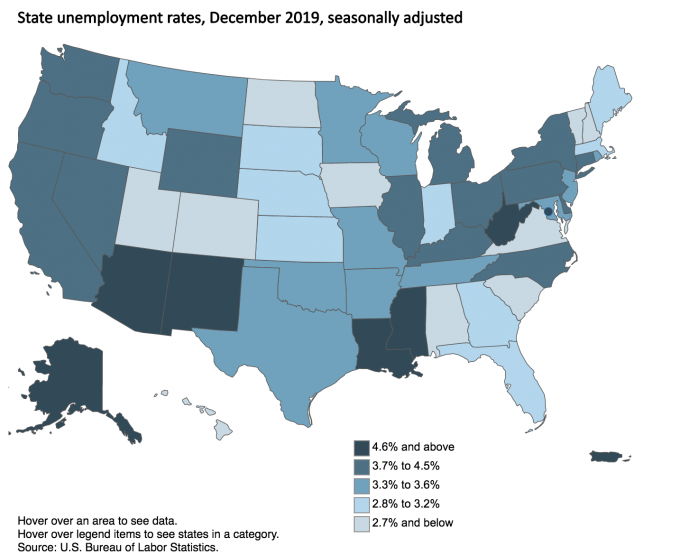by Valorie H. Rice
Senior Specialist, Business Information
Current data releases as of 24 January 2020
Idaho and Nevada are the fastest-growing states in the nation followed by Arizona and Utah based on Census Bureau annual population estimates for the U.S. and states released on December 30. Idaho posted 2.1 percent growth between July 1, 2018 and July 1, 2019 followed by Nevada, Arizona, and Utah all listed at 1.7 percent. Ten states had population losses over the year, with West Virginia losing the largest percentage of population at -0.7 percent. The U.S. population grew by 0.5 percent. This continues a trend of slowing population growth noted by the Census Bureau. The release indicated that fewer births in the last several years coupled with increasing number of deaths has led to a decline in natural increase (births minus deaths) over the last decade. Even though Arizona is among the fastest growing states in the nation, declining births are still an issue, as a recent article from our director George Hammond describes in Arizona’s Baby Bust: Birth Rates Decline 22% in a Decade.
Job growth in Arizona was 2.9 percent over-the-year in December before seasonal adjustment. This was 1.5 percentage points higher than the nation, which posted 1.4 percent growth. Job growth in Arizona metro areas were as follows: Lake Havasu-Kingman 3.3 percent, Phoenix 3.2 percent, Tucson 2.3 percent, Sierra Vista-Douglas and Prescott both at 2.1 percent, Flagstaff 0.3 percent, and Yuma declining 0.3 percent. Education and health services was the sector with the most over-the-year gains in employment for the state while information was the only sector reporting losses. The seasonally adjusted unemployment rate for Arizona moved down to 4.6 percent in December, the lowest it has been since January 2008.
Despite the fact Arizona posted its lowest unemployment rate in over a decade, it was still among the states with the highest seasonally adjusted unemployment rates in the nation. Only five states and the District of Columbia had higher unemployment rates than Arizona in December, with Alaska topping in at 6.1 percent. South Carolina, Utah, and Vermont had the lowest unemployment rates for the month, all at 2.3 percent. There were eight states that reached record low unemployment rates according to a January 24 Bureau of Labor Statistics state employment and unemployment release.

Arizona real GDP by state increased at a seasonally adjusted annual rate of 2.4 percent in the third quarter 2019. Other western states fared a bit better as Texas had the highest increase in real GDP for the quarter at 4.0 percent followed by Utah at 3.2 percent. Delaware had zero increase, placing it at the bottom of all states. The U.S. growth rate was 2.1 percent according to the January 10 Bureau of Economic Analysis release.
U.S. nonfarm payroll employment increased 145,000 in December. Employment gains averaged 184,000 per month over the last three months after downward revisions to October and November employment figures according to the January 10 Bureau of Labor Statistics release. Retail trade and health care contributed to over-the-month job gains while mining jobs decreased. Average hourly earnings increased 2.9 percent over-the-year in December. The U.S. unemployment rate was unchanged at 3.5 percent.
The U.S. trade deficit lowered to $43.1 billion in November, down $3.9 billion from the revised October figure. Imports continued to fall while exports increased over-the-month. Exports rose $1.4 billion to $208.6 billion in November while imports decreased $2.5 billion to $251.7 billion. The year-to-date deficit of goods and services shifted to a decrease of 0.7 percent compared to the same period a year ago according to the January 7 joint release from the Bureau of Economic Analysis and Census Bureau.
The Consumer Price Index increased 0.2 percent in December on a seasonally adjusted basis according to the January 14 Bureau of Labor Statistics release. Gasoline and medical care increases accounted for a large chunk of the rise in the overall price index. The food index increased 0.2 percent for the month and all items minus food and energy rose 0.1 percent. The annual inflation rate was 2.3 percent for December.
Arizona bankruptcy filings increased slightly for the third year in a row. There were 503 more bankruptcies in 2019 than 2018. Business liquidation (Chapter 7) and individual debt adjustment (Chapter 13) are the most likely filings in Arizona. They increased 3.0 percent and 3.9 percent, respectively. Lesser-used filings also increased with reorganization (Chapter 11) rising 5.2 percent for the year and family farm (Chapter 12) totaling 5 for 2019, a 66.7 percent increase over 2018. All three offices had increases in filings, Phoenix with 4.2 percent, Tucson 0.6 percent, and Yuma 2.1 percent. The Phoenix office includes Apache, Coconino, Gila, Maricopa, Navajo, and Yavapai counties, among which Yavapai had the highest percent increase in bankruptcies for the year. The Tucson office handles Cochise, Graham, Greenlee, Pima, Pinal, and Santa Cruz counties, with Santa Cruz having the largest percent increase of all counties in the state. The Yuma office represents La Paz, Mohave, and Yuma counties of which Yuma was the only county posting an increase in bankruptcies for 2019.
Phoenix house prices gained 5.8 percent over-the-year in October, placing in the top spot out of all metropolitan areas in the S&P CoreLogic Case-Shiller Index for the fifth consecutive month. Tampa at 4.9 percent and Charlotte at 4.8 percent rounded out the top three metros. San Francisco was the only place with a decline in over-the-year house prices at –0.4 percent. House prices in the national index increased 3.3 percent over-the-year in October and the 20-city composite increased 2.2 percent. The December 31 release noted both of these were higher than the previous month, which marked a change from a long period of decelerating price increases.






